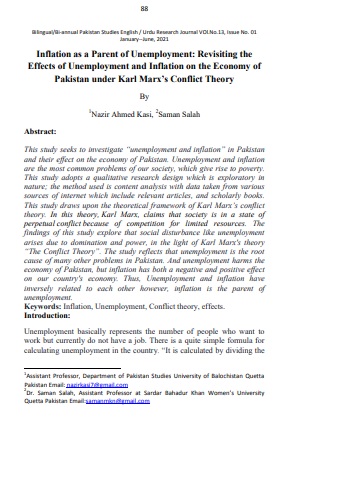Inflation as a Parent of Unemployment: Revisiting the Effects of Unemployment and Inflation on the Economy of Pakistan under Karl Marx’s Conflict Theory
Keywords:
Inflation, Unemployment, Conflict theory, effects.Abstract
This study seeks to investigate “unemployment and inflation” in Pakistan
and their effect on the economy of Pakistan. Unemployment and inflation
are the most common problems of our society, which give rise to poverty.
This study adopts a qualitative research design which is exploratory in
nature; the method used is content analysis with data taken from various
sources of internet which include relevant articles, and scholarly books.
This study draws upon the theoretical framework of Karl Marx‟s conflict
theory. In this theory, Karl Marx, claims that society is in a state of
perpetual conflict because of competition for limited resources. The
findings of this study explore that social disturbance like unemployment
arises due to domination and power, in the light of Karl Marx's theory
“The Conflict Theory”. The study reflects that unemployment is the root
cause of many other problems in Pakistan. And unemployment harms the
economy of Pakistan, but inflation has both a negative and positive effect
on our country's economy. Thus, Unemployment and inflation have
inversely related to each other however, inflation is the parent of
unemployment.
References
Amjad, R. (2005). Pakistan's Poverty Reduction Strategy: Why
Employment Matters. The Lahore Journal of Economics (Special
Edition) , 145-178.
Bhorat, H. (2007). Unemployment in South Africa: Descriptors and
Determinants. Washington DC.: World Bank.
Bruno, M. and W. Easterly (1996). Inflation Crisis and Long-Run Growth,
Journal of Monetary Economics, 41, 1.
Catao, L. and Terrones, M. (2003).Fiscal deficits and Inflation. IMF
working paper series, 3 (65).
Chang, S.-C. (2006). The dynamic interactions among foreign direct
investment, economic growth, exports and unemployment:
evidence from Taiwan. Economic Change(38), 235-256.
Chaudhary M, Hamid A (1998) Unemployment in Pakistan. Pakistan
Economic and Social Review 36(2):147–170.
Eita JH, Ashipala JM (2010) Determinants of unemployment in Pakistan.
International Jour-nall of Business and Management 5(10):92–104.
Emst (2011) Determinants of unemployment flows, labour market
institutions and macroe-conomic policies. Discussion paper,
International Institute for Labour Studies.
Hunt J (1999) Determinants of non-employment and unemployment
durations in east Ger-many. CEPR Discussion Papers 2182,
C.E.P.R. Discussion Papers.
Khan SR, Ali SZ, Malik SJ (1986) Some findings about the unemployed
highly educated persons in Pakistan. The Pakistan Development
Review 25(4):731–736.
Kingdon, G., & Knight, J. (2001). Race and the Incidence of
Unemployment in South Africa. Centre for the Study of African
Economies Working Papers.
Kupets, O. V. (2005). Determinants of unemployment duration in
Ukraine-Moscow. : EERC.” Economics Education and Research
Consortium.
Mallik, G., and Chowdhury, A. (2001). Inflation and Economic Growth:
Evidence from Four South Asian. Countries. Asia-Pacific
Development Journal, 8(1), 123-135.
Mankiw, N. G. (2001). The Inexorable and Mysterious Tradeoff Between
Inflation and Unemployment. The Economic Journal, 111(471),
-61.
Maqbool, M. S., Sattar, T. M. A., and Bhalli, M. N. (2013). Determinants
of Unemployment: Empirical Evidences from Pakistan. Pakistan
Economic and Social Review, 51(2), 191-207.
Marika Karanassou, Hector Sala, & Salvador, P. F. (2007). Capital
Accumulation and Unemployment: Capital Accumulation and
Unemployment: new insights on the Nordic, experience.
Economics review, 90(2), 1223-1322.
Mishkin, F. S., and Posen, A. S. (1998). Inflation Targeting: Lessons from
Four Countries: Working Paper no.6126). National Bureau of
Economic Research.
Nickell, S. (1997). Unemployment and Labor Market Rigidities: Europe
Versus North America. The Journal of Economic Perspectives,
(3), 55-74.
Qayyum W (2007) Causes of youth unemployment in Pakistan. The
Pakistan Development Review 46(4):611–621.
Rafiq M, Ahmad I, Ullah A et al (2010) Determinants of unemployment:
A case study of Pakistan economy (1998-2008). Abasyn Journal of
Social Sciences 3(1):17–24.
Samuelson, P.A. and Solow, R.M. (1960). Analytical Aspect of Antiinflation Policy. American Economic Review, 50, pp.177-194.
Solow, R.M. (1970). Discussion of RJ Gordon‟s Recent Acceleration of
Inflation and its Lessons for the Future. Brookings Papers on
Economic Activities, 1, pp.42-46.
Zaidi, S.A (2005). The Issues in Pakistan Economy. Oxford University
Press, Karachi.
Online Sources:
https://www.investopedia.com/terms/c/conflict-theory.asp
https://www.job-interview-site.com/the-effects-of-unemployment-onsociety-and-the-economy.html
https://www.investopedia.com/terms/p/phillipscurve.asp



